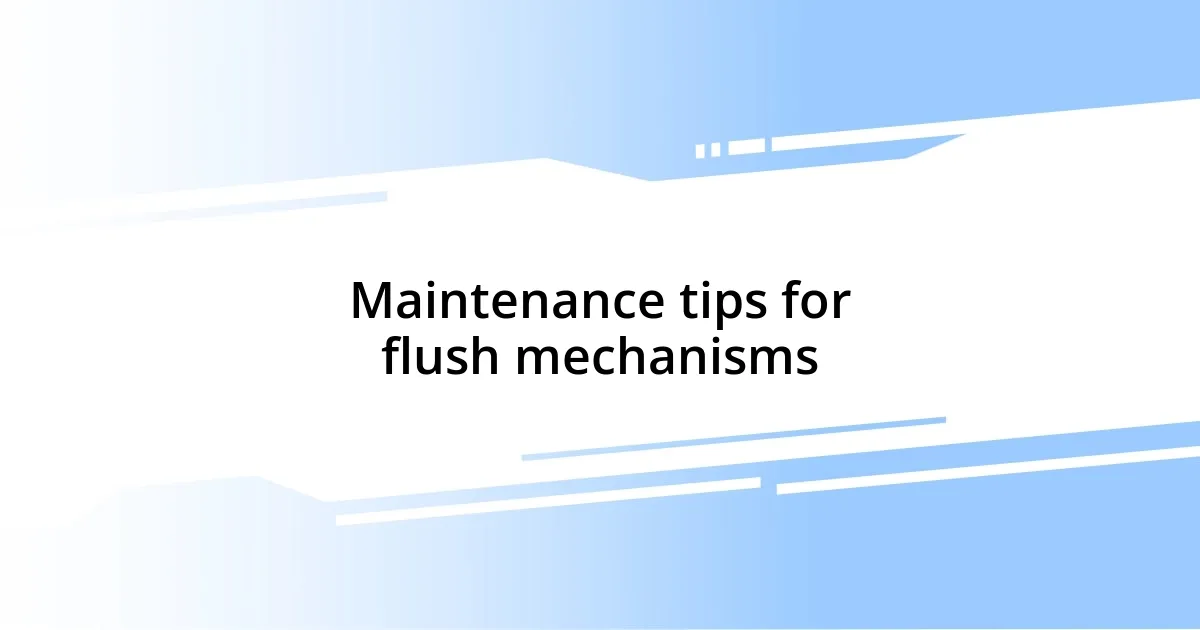Key takeaways:
- Flush mechanisms involve interconnected components like the flapper, float, and flush valve, critical for proper toilet function.
- Common issues include weak flushes due to warped flappers, sticking floats, and leaks from worn washers.
- Regular maintenance, such as inspecting components and cleaning, can prevent major plumbing problems.
- Consulting a plumber is advisable for persistent issues or when DIY fixes are unsuccessful, ensuring home safety and integrity.

Understanding flush mechanisms
Flush mechanisms are fascinating in their simplicity and complexity. When I first started tinkering with them, I was surprised to discover that a mere lever pull initiates a series of interconnected actions. It’s as if you’re flipping a small switch that sets off a chain reaction, pushing water into the bowl and pulling waste away. Have you ever thought about how something so small makes such a significant difference in our daily routines?
As I explored further, I realized that there are various types of flush mechanisms—like gravity-fed or pressure-assisted systems. Each has its quirks and benefits. I remember fixing a stubborn dual-flush system in my own home. The frustrating moment when I pulled the lever and nothing happened made me appreciate the intricate workings behind these mechanisms. It’s like a dance of physics and engineering, all working in harmony to ensure our bathrooms function seamlessly.
Understanding these mechanisms is crucial for anyone looking to maintain or repair their toilets effectively. I can see now how having a grasp of the components—like the flapper, float, and flush valve—can empower homeowners to tackle minor plumbing issues. Have you ever felt that rush of satisfaction after figuring something out on your own? It’s incredible how a little knowledge can make you feel like a true DIY-er.

Common problems with flush mechanisms
When dealing with flush mechanisms, one common problem is a weak or incomplete flush. I remember a time when I visited a friend’s house and was greeted with a toilet that seemed to just murmur rather than flush. It turned out that the flapper was slightly warped, preventing a proper seal. In those cases, it’s crucial to inspect the flapper and ensure it’s not letting water seep in at odd angles.
Another frequent issue is the float sticking, which can leave your toilet constantly running. I encountered this once while hosting a family gathering, and the incessant sound became an unwelcome background soundtrack. This can usually be resolved by adjusting the float arm or cleaning the mechanism, but there’s something satisfying about the remedy—like releasing a trapped bird back into the sky.
Lastly, leaks can be a persistent nuisance, manifesting from worn washers or faulty connections. I had a mishap when a seemingly minor leak turned my bathroom into a mini-water feature while I was entirely unaware. It’s often easy to ignore small puddles, but I learned that those leaks can lead to bigger problems down the line. Spotting and addressing them quickly is key to preventing significant damage.
| Common Problems | Possible Causes |
|---|---|
| Weak/Incomplete Flush | Warped flapper or low water level |
| Float Sticking | Misadjusted float arm or debris |
| Leaks | Worn washers or loose connections |

Maintenance tips for flush mechanisms
Sometimes, maintenance feels more like a bonding ritual with your toilet. Regular checks can save you from headaches later on. I learned this the hard way when I let a small issue slide, only to face a late-night plumbing emergency. Now, I recommend keeping an eye on key components regularly. A simple routine can extend the life of your flush mechanism and prevent those frustrating surprises.
Here are some maintenance tips I’ve found useful:
-
Inspect the flapper: Make sure it seals well and isn’t warped. A well-functioning flapper can save water and ensure a complete flush.
-
Check the float level: The float should be adjusted so that the tank fills to the correct level. This little adjustment can make a huge difference.
-
Look for leaks: Regularly check for any water pooling around the base. A thorough visual inspection can help catch issues early before they escalate.
-
Clean the parts: Mineral buildup can impact performance. I’ve learned that a gentle scrub with vinegar can work wonders, just like giving your toilet a nice spa day.
-
Replace worn parts: If anything looks frayed or damaged, don’t hesitate to swap it out. Trust me, it’s easier than dealing with leaks later!
Taking these steps not only helps with functionality but gives you peace of mind. It’s empowering to know you’re proactively caring for your home. Each small win in maintenance can bring a comforting sense of control, like mastering your little corner of the plumbing universe.

When to call a plumber
Knowing when to call a plumber can save you from unnecessary stress and cost. If you find yourself troubleshooting persistent issues—like that annoying wobble in your flush handle or a mysterious water pool by the base—it might be time to get a professional involved. I learned this the hard way after trying to fix a stubborn leak only to realize that the connections required specialized tools and expertise beyond my reach.
Sometimes, the symptoms seem minor but could indicate a larger problem lurking beneath the surface. I remember when my flush mechanism started making strange noises; it felt like my toilet was trying to communicate. After weeks of ignoring those sounds and a few small fixes, the situation escalated to a full-blown plumbing disaster. If your attempts at DIY haven’t yielded results after a couple of tries, don’t hesitate. Calling a plumber could be the best decision you make to maintain the integrity of your plumbing system.
Lastly, there’s a certain level of comfort that comes from knowing your home is in good hands. When I finally decided to reach out to a plumber, the relief I felt was palpable. They not only resolved the issue quickly but also educated me on prevention strategies. Think about it: isn’t it worth it to entrust complicated plumbing tasks to experts, ensuring your home remains a safe and cozy space?

Advanced troubleshooting for flush mechanisms
When diving into advanced troubleshooting for flush mechanisms, I often find that the most common issue lies in the internal components. One time, I was perplexed by a tank that wouldn’t fill properly, despite the float appearing normal. After further investigation, I discovered that a small piece of debris was blocking the inlet valve. It was a simple fix, but those tiny culprits can lead to big headaches if ignored.
Sometimes, flushing issues stem from the choice of materials used in the mechanism. I once encountered a situation where a plastic flapper had deteriorated prematurely due to harsh chemical cleaners. It can be tempting to reach for those strong cleaners, but they can wreak havoc on the insides of your toilet. Investing in higher-quality replacements made a world of difference in both performance and longevity.
If you ever find a persistent gurgling noise when flushing, don’t overlook vent stack blockages. In one particular instance, the sound was so unsettling that I thought my toilet was possessed! After a bit of sleuthing, I realized that leaves had clogged the vent on the roof. Clearing that blockage brought an unexpected sense of relief. Isn’t it fascinating how something so simple can affect the whole system? Engaging with these troubles gives us a deeper understanding of our plumbing’s inner workings and reminds us of the smaller nuances we often take for granted.














